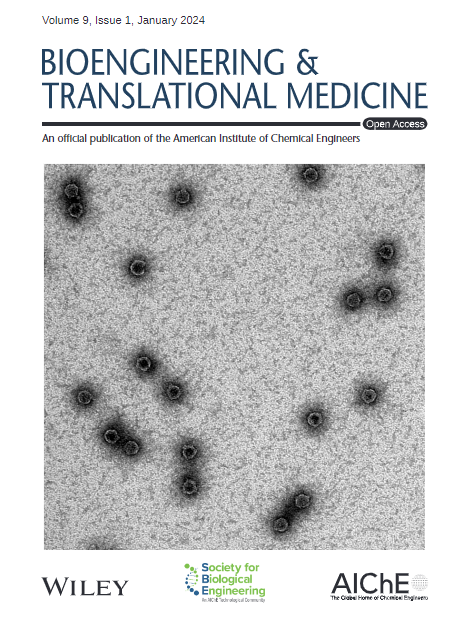Neuron‐targeted 2‐deoxyglucose‐dendrimer‐rosiglitazone nanotherapy mitigates neuroinflammation and cognitive deficits in pediatric traumatic brain injury
IF 5.7
2区 医学
Q1 ENGINEERING, BIOMEDICAL
引用次数: 0
Abstract
Traumatic brain injury (TBI) remains a major global health challenge, characterized by high morbidity and mortality rates. Despite advances in neuroscience, the blood–brain barrier (BBB) limits the effectiveness of potential neuroprotective treatments. Recent nanotechnology breakthroughs have led to smart drug delivery systems that can cross the BBB and target injured brain areas. However, achieving the specificity needed to deliver therapies to affected neurons remains a challenge. In previous work, we developed a mixed‐layered dendrimer functionalized with 2‐deoxyglucose (2DG‐D) for selective neuronal drug delivery. In this study, we explore the therapeutic potential of rosiglitazone (Rosi) for pediatric TBI by creating a 2DG‐D‐Rosi nanosystem, where Rosi is conjugated to 2DG‐D to improve its solubility, bioavailability, and targeted delivery to injured neurons. In vitro, 2DG‐D‐Rosi demonstrated high neuronal uptake, sustained drug release, and excellent biocompatibility. It significantly reduced neuronal apoptosis, reactive oxygen species formation, pro‐inflammatory cytokine expression, and caspase activity, outperforming free Rosi. In vivo, using a pediatric TBI mouse model, 2DG‐D‐Rosi improved neuronal targeting, reduced neuroinflammation, and enhanced behavioral outcomes. This research highlights 2DG‐D‐Rosi as a promising nanotherapeutic platform for precise TBI treatment and sets the stage for developing more effective therapies for this challenging condition.神经元靶向2 -脱氧葡萄糖-树突状聚合物-罗格列酮纳米疗法减轻小儿创伤性脑损伤的神经炎症和认知缺陷
外伤性脑损伤(TBI)仍然是一个主要的全球健康挑战,其特点是发病率和死亡率高。尽管神经科学取得了进步,但血脑屏障(BBB)限制了潜在的神经保护治疗的有效性。最近的纳米技术突破已经导致了智能药物输送系统,可以穿过血脑屏障,瞄准受伤的大脑区域。然而,实现对受影响神经元提供治疗所需的特异性仍然是一个挑战。在之前的工作中,我们开发了一种具有2 -脱氧葡萄糖(2DG - D)功能化的混合层状树状大分子,用于选择性神经元药物递送。在这项研究中,我们通过创建2DG‐D‐Rosi纳米系统来探索罗格列酮(Rosi)对儿科TBI的治疗潜力,其中Rosi与2DG‐D结合以提高其溶解度,生物利用度和靶向递送到受损神经元。在体外,2DG‐D‐Rosi表现出高的神经元摄取、持续的药物释放和良好的生物相容性。它显著降低了神经元凋亡、活性氧形成、促炎细胞因子表达和半胱天冬酶活性,优于游离Rosi。在体内,使用儿童TBI小鼠模型,2DG‐D‐Rosi改善了神经元靶向性,减少了神经炎症,并增强了行为结果。这项研究突出了2DG - D - Rosi作为精确治疗TBI的有前途的纳米治疗平台,并为开发更有效的治疗这种具有挑战性的疾病奠定了基础。
本文章由计算机程序翻译,如有差异,请以英文原文为准。
求助全文
约1分钟内获得全文
求助全文
来源期刊

Bioengineering & Translational Medicine
Pharmacology, Toxicology and Pharmaceutics-Pharmaceutical Science
CiteScore
8.40
自引率
4.10%
发文量
150
审稿时长
12 weeks
期刊介绍:
Bioengineering & Translational Medicine, an official, peer-reviewed online open-access journal of the American Institute of Chemical Engineers (AIChE) and the Society for Biological Engineering (SBE), focuses on how chemical and biological engineering approaches drive innovative technologies and solutions that impact clinical practice and commercial healthcare products.
 求助内容:
求助内容: 应助结果提醒方式:
应助结果提醒方式:


